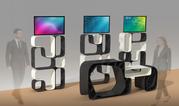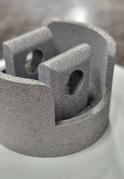Share on:
Nov 12, 2025 7:47 am
Experts from Fraunhofer IWU will present new materials for additive manufacturing at their self-printed stand
The focus of this year's exhibitions at Formnext is on materials that are particularly suitable for aerospace applications but have so far rarely been used in LPBF (Laser Powder Bed Fusion) processes, as well as printed components with integrated electrical functions. But the stand itself is also a highlight: It is completely 3D printed and consists of elements made of biodegradable plastic and recyclable polypropylene (PP). After the event, the module system will not be discarded. The high-quality exhibition furniture will be reassembled and repurposed for presentation purposes at the Fraunhofer IWU.
+++ Fraunhofer exhibition at Formnext, Frankfurt am Main, 18–21. November, Hall 11, Stand D31 +++
In the Laser Powder Bed Fusion (LPBF) process, metal powder is selectively melted using a laser beam and solidified layer by layer, creating components with high geometric precision. The Dresden branch of the Fraunhofer IWU recently purchased a high-temperature LPBF system that, depending on the material requirements, enables the powder bed surface to be preheated to temperatures of up to 1200 °C. This enables easier processing of high-melting metals such as tungsten, as well as metallic materials with similar thermal properties such as titanium aluminide. While these materials are primarily processed in industry using electron beam melting (EBM), high-temperature LPBF opens new possibilities for higher resolution, particularly thin-walled structures, and precise control of the resulting microstructure.
In particular, this technology enables the production of extremely light yet extremely wear- and temperature-resistant components, which are particularly important for high-performance engine parts, turbocharger systems or heat exchangers in the aerospace industry.
Aluminum Matrix Composites (AMC): Combination of lightweight construction and improved wear resistance
Particle-reinforced AMCs offer low density and high wear resistance, making them attractive lightweight materials for automotive and aerospace applications. The research team around Dr. Florian Bittner integrates silicon carbide (SiC) particles as a reinforcing phase in aluminum matrix powder in order to significantly improve the tribological properties, such as wear resistance.
High temperature aluminum alloys for operating temperatures up to 300°C
Constellium Aheadd® HT2 is a heat-resistant aluminum alloy for aerospace applications that can withstand operating temperatures of approximately 250-300°C depending on mechanical stress and operating time. The LPBF technology also opens up new possibilities for producing delicate structures with increased geometric freedom from this alloy. Fraunhofer IWU is developing appropriate process strategies and parameter windows to enable reliable processing of this alloy in LPBF technology.
Cost-effective and environmentally friendly (large-scale) 3D printing: Ideal for exhibition furniture, long-lasting components and special tools
For the exhibition stand, experts from Zittau and Chemnitz used biodegradable plastic (for light-colored components) and recyclable polypropylene (for black components). The latter significantly reduces manufacturing costs. The base material is an inexpensive granulate that already contains recycled carbon fibers and can be melted down again indefinitely. Only 55 kg of black-colored granules were needed to “print” the three shelves and the counter, with a total production time of just under 13 hours. With a lean sales concept, a counter like the one presented in Frankfurt could be sold inexpensively for around 1,500 euros. The modular system, which is easy to assemble and reconfigure, offers great flexibility in displaying items. If there is enough space, the shelves and counters can be placed freely in the room, thus offering “unobstructed” views from several angles. If space is limited, the system can also be aligned on (temporary) walls. The individual components can be transported to save space; The counter (170 cm wide, 110 cm high and 50 cm deep) is an excellent example of large-format 3D printing. Thanks to its sandwich construction, it is light and yet highly resilient. These properties are also advantageous for installation in special vehicles, for example. The Fraunhofer IWU uses the geometric freedom and relatively short manufacturing times to produce individual special tools, such as handling systems for industrial robots or molds and devices.
Another highlight at Fraunhofer IWU's Formnext stand is the integration of electrical functions into components using the WEAM process.
Original publication:
https://www.iwu.fraunhofer.de/de/presse/2025-fraunhofer-iwu-experts-presentieren-neue-m…
Further information:
https://www.iwu.fraunhofer.de/de/presse/2025-integration-elektricer-funktionen-dir… More detailed information about the WEAM exhibitions at Formnext
https://www.additiv.fraunhofer.de/de/uebersicht-exponate-formnext-2025.html Detailed list of exhibits from the Fraunhofer Competence Field of Additive Manufacturing at Formnext
Pictures

Rendering of the Fraunhofer IWU stand at Formnext. Visitors can view the exhibits from several sides …
Copyright: © Fraunhofer IWU I Constanze Kuring

Aluminum matrix composites combine low density with excellent wear resistance.
Copyright: © Fraunhofer IWU
 Press release
Press release
Criteria of this press release:
Business and trade, journalists, scientists
Economics/Business Administration, Electrical Engineering, Materials Science, Mechanical Engineering
supraregional, national
Research results, science or research transfer
English
